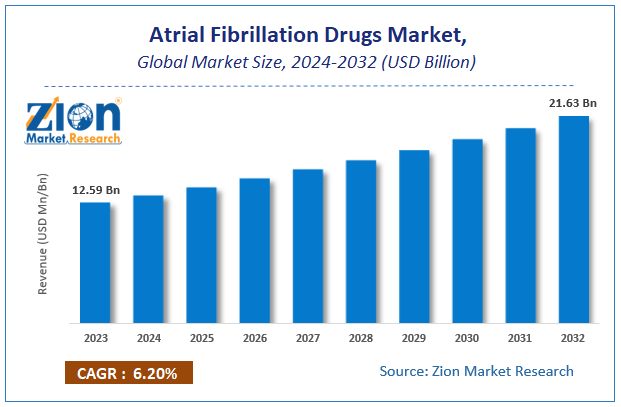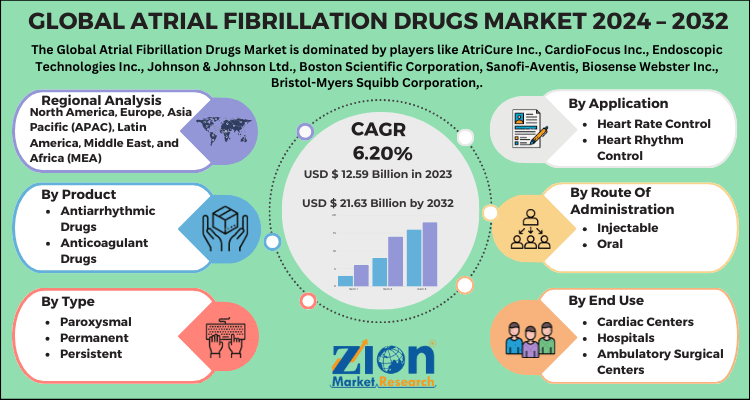Atrial Fibrillation Drugs Market Size, Share, Trends, and Growth 2032

Atrial Fibrillation Drugs Market - By Type (Permanent, Paroxysmal, And Persistent), By Product (Anticoagulant Drugs And Antiarrhythmic Drugs), By Route Of Administration (Oral And Injectable), By Application (Heart Rhythm Control And Heart Rate Control), By End Use (Hospitals, Cardiac Centers, And Ambulatory Surgical Centers), And By Region - Global And Regional Industry Overview, Market Intelligence, Comprehensive Analysis, Historical Data, And Forecasts 2024-2032
| Market Size in 2023 | Market Forecast in 2032 | CAGR (in %) | Base Year |
|---|---|---|---|
| USD 12.59 Billion | USD 21.63 Billion | 6.20% | 2023 |
Atrial Fibrillation Drugs Market: Size
The global atrial fibrillation drugs market? size was worth around USD 12.59 billion in 2023 and is predicted to grow to around USD 21.63 billion by 2032 with a compound annual growth rate (CAGR) of roughly 6.20% between 2024 and 2032.
The report offers valuation and analysis of the atrial fibrillation drugs market on a global as well as regional level. The study offers a comprehensive assessment of the industry competition, restraints, revenue estimates, avenues, current & emerging trends, and industry-validated market information. The report offers historical data from 2018 to 2022 along with a forecast from 2024 to 2032 based on value (USD Billion).
Atrial Fibrillation Drugs Market: Introduction
Atrial fibrillation is the most common type of cardiac arrhythmia observed in medical fraternity and is the key cause of mortality & morbidity. It also results in hospital admissions and affects cardiac activity along with raising the risk of heart failure and myocardial infarction among the aging population. Elderly population suffering from chronic ailments has resulted in rise in the diagnosis of atrial fibrillation as the probability of occurrence of latter increases with the age. According to NCBI, atrial fibrillation is related to high risks including systemic embolism, transient ischemic attack, ischemic stroke, or even death.
Furthermore, atrial fibrillation is the result of abnormal electrical event occurring inside the heart atria. It is also categorized as tachyarrhythmia meaning fast heart rate. During atrial fibrillation, the problem arises in the natural pacemaker signals of heart and the rate of heart becomes fast and irregular causing palpitations or faint in the person. This is as a result of inability of the heart to pump blood to all parts of human internal system.
Additionally, the condition of tachyarrhythmia or fast & irregular heart rate can last for lesser than a week or even more than a week. Sometimes, it can last for over a year or can even be long lasting/permanent. Irregular heart rate can result in turbulent blood flow through heart causing blood clot, thereby leading to heart stroke. Apparently, atrial fibrillation can make the heart weak over the period.
Moreover, the risk aspects of atrial fibrillation comprise hypertension, coronary artery ailment, lung disease, hemodynamic stress, obstructive sleep apnea, huge alcohol intake, endocrine disorders, neurological disorders, advanced age, genetic defects, inflammation, and congenital heart disorder. Symptoms for atrial fibrillation can differ and may include breath shortness, chest pain, nausea, severe sweating, dizziness, and fatigue. Furthermore, atrial fibrillation can be treated with inoculation of anticoagulation medicines, intervening cardiac methods, heart rhythm control drugs, ablation, and cardioversion.
Atrial Fibrillation Drugs Market: Growth Dynamics
For large number of patients not requiring direct cardioversion intervention, anti- arrhythmic drug treatments are used. Apart from this, these drug therapies proficiently transform atrial fibrillation to normal sinus rhythm in patients when the drug dose is administered in patients quickly & adequately. All these aforementioned factors is anticipated to steer the market trends.
Moreover, Digoxin is utilized as a medication to slow the heart rate. However, it has proved less effective against hyperadrenergic subjects. Hence, calcium channel blockers like diltiasem & verapamil and beta blockers like metoprolol and esmolol are used for hyperadrenergic patients. These drugs are effective as compared to Digoxin.
In addition to this, Dronedarone drug is used for the patients with paroxysmal & persistent atrial fibrillation and is not used for the patients with heart failure history & having permanent atrial fibrillation. Apart from this, novel antithrombotic agents have the potential to prevent heart stroke in the subjects affected due to atrial fibrillation. All these aspects have translated into huge demand for the atrial fibrillation drugs.
According to NCBI, drugs can help in controlling heart rate and rhythm in patients with inception of atrial fibrillation. Additionally, anticoagulant medicines are used for atrial fibrillation patients who are more prone to blood clotting in their atria that can result in heart stroke. Moreover, patients having valvular atrial fibrillation are prescribed warfarin in anticoagulation therapy. This, in turn, is likely to enlarge the market scope and enhance the business space over the forecasting years.
As per NCBI study, Eplerenone, an mineralocorticoid receptor blocking drug, has proved to be successful in preventing the recurrence of atrial fibrillation in patients post catheter ablation procedure. Additionally, medical research study and clinical tests have proved that candesartan, an angiotensin receptor blocker, helps in reducing atrial fibrillation propensity. Additionally, apixaban also helps in effectively treating systemic embolism and avoiding heart stroke. All these factors will not only accentuate the market growth in the coming years but will generate lucrative business growth avenues & create new growth dimensions for the industry players over the coming years.
Some of the competitive moves made by the key participants are likely to leverage the growth of atrial fibrillation drugs industry. Let us discuss the few of them:
U.S. FDA approves AltaThera Pharmaceuticals LLC’s Novel Sotalol IV Indications In Atrial Fibrillation Patients
In a major breakthrough witnessed in atrial fibrillation drugs industry, in March 2020, FDA approved new Sotalol IV indications in atrial fibrillation patients. The move is predicted to reduce the stay of patients in hospitals, thereby enhancing the patient satisfaction along with reducing their hospital costs. Reportedly, it will also benefit doctors and save hospital costs. Furthermore, the firm is likely to launch the new Sotalol IV indications in the second half of 2020.
Atrial Fibrillation Drugs Market: Report Scope
| Report Attributes | Report Details |
|---|---|
| Report Name | Atrial Fibrillation Drugs Market Research Report |
| Market Size in 2023 | USD 12.59 billion |
| Market Forecast in 2032 | USD 21.63 billion |
| Growth Rate | CAGR of 6.20% |
| Number of Pages | 110 |
| Key Companies Covered | AtriCure Inc., CardioFocus Inc., Endoscopic Technologies Inc., Johnson & Johnson Ltd., Boston Scientific Corporation, Sanofi-Aventis, Biosense Webster Inc., Bristol-Myers Squibb Corporation, St. Jude Medical Inc., Boehringer Ingelheim GmbH. |
| Segments Covered | By Product, By Type, By Application, By Route Of Administration, By End Use, And By Region |
| Regions Covered | North America, Europe, Asia Pacific (APAC), Latin America, Middle East, and Africa (MEA) |
| Base Year | 2023 |
| Historical Year | 2018 to 2022 |
| Forecast Year | 2024 - 2032 |
| Customization Scope | Avail customized purchase options to meet your exact research needs. Request For Customization |
Atrial Fibrillation Drugs Market: Regional Analysis
North America To Contribute Notably Towards Overall Market Growth By 2032
The regional market growth over the forecast timeline is owing to massive surge in the geriatric population that is susceptible to valvular ailments. Apart from this, large-scale presence of major pharma firms like Bristol-Myers Squibb and Johnson & Johnson in the countries like the U.S. will further boost the regional market trends.
Atrial Fibrillation Drugs Market: Key Players Analysis
Key players profiled in the report include:
- AtriCure Inc.
- CardioFocus Inc.
- Endoscopic Technologies Inc.
- Johnson & Johnson Ltd.
- Boston Scientific Corporation
- Sanofi-Aventis
- Biosense Webster Inc.
- Bristol-Myers Squibb Corporation
- St. Jude Medical Inc.
- Boehringer Ingelheim GmbH.
The global atrial fibrillation drugs market is segmented as follows:
By Product
- Antiarrhythmic Drugs
- Anticoagulant Drugs
By Type
- Paroxysmal
- Permanent
- Persistent
By Application
- Heart Rate Control
- Heart Rhythm Control
By Route Of Administration
- Injectable
- Oral
By End Use
- Cardiac Centers
- Hospitals
- Ambulatory Surgical Centers
By Region
- North America
- The U.S.
- Canada
- Europe
- France
- The UK
- Spain
- Germany
- Italy
- Rest of Europe
- Asia Pacific
- China
- Japan
- India
- South Korea
- Southeast Asia
- Rest of Asia Pacific
- Latin America
- Brazil
- Mexico
- Rest of Latin America
- Middle East & Africa
- GCC
- South Africa
- Rest of Middle East & Africa
Table Of Content
Methodology
FrequentlyAsked Questions
Atrial fibrillation is the most common type of cardiac arrhythmia observed in medical fraternity and is the key cause of mortality & morbidity. It also results in hospital admissions and affects cardiac activity along with raising the risk of heart failure and myocardial infarction among the aging population.
According to study, the global Atrial Fibrillation Drugs Market size was worth around USD 12.59 billion in 2023 and is predicted to grow to around USD 21.63 billion by 2032.
The CAGR value of Atrial Fibrillation Drugs Market is expected to be around 6.20% during 2024-2032.
North America has been leading the global Atrial Fibrillation Drugs Market and is anticipated to continue on the dominant position in the years to come.
The global Atrial Fibrillation Drugs Market is led by players like AtriCure Inc., CardioFocus Inc., Endoscopic Technologies Inc., Johnson & Johnson Ltd., Boston Scientific Corporation, Sanofi-Aventis, Biosense Webster Inc., Bristol-Myers Squibb Corporation, St. Jude Medical Inc., Boehringer Ingelheim GmbH.
RelatedNews
HappyClients
Zion Market Research
Tel: +1 (302) 444-0166
USA/Canada Toll Free No.+1 (855) 465-4651
3rd Floor,
Mrunal Paradise, Opp Maharaja Hotel,
Pimple Gurav, Pune 411061,
Maharashtra, India
Phone No +91 7768 006 007, +91 7768 006 008
US OFFICE NO +1 (302) 444-0166
US/CAN TOLL FREE +1 (855) 465-4651
Email: sales@zionmarketresearch.com
We have secured system to process your transaction.
Our support available to help you 24 hours a day, five days a week.
Monday - Friday: 9AM - 6PM
Saturday - Sunday: Closed






